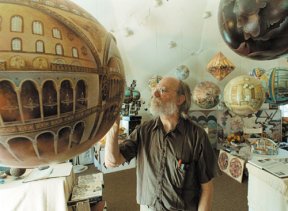The world of artist Dick Termes is a world of spheres—big spheres, little spheres, transparent spheres, and, most of all, painted spheres.





Based in Spearfish, S.D., Termes has been painting on spheres for more than 30 years. His intriguing creations embody the notion of capturing complete worlds—top, bottom, and all around—on a spherical canvas.
Termes takes a unique perspective in his art. In effect, he imagines crawling inside a transparent ball, then looking out with one eye in all directions from a center point. He then transfers what he sees onto the outside of a sphere.
Suppose, for example, that the ball he’s inside is in a starkly geometric, cubical room. The room is defined by three sets of parallel lines. From his perspective inside the ball, these lines lead to six vanishing points. And the lines are curved. This six-point perspective, with the six vertices of an octahedron serving as the vanishing points, becomes the basis of his spherical paintings.
In essence, Termes geometrically translates the view from inside a sphere to the outside of one.
Hung from a rod, the balls painted by Termes slowly rotate, presenting six different viewpoints. Amazingly, as you stare at the revolving sphere, it appears to pop inside out. You feel as if you’re sucked inside to get a weirdly distorted, inside-out view of the painted scene. It’s a remarkable optical illusion.
Termes has painted all sorts of scenes on the surface of spheres, including the interiors of famous buildings, many different geometric patterns, and various imaginary “dream” worlds (see http://www.termespheres.com/gallery1.html).
Termes has painted scenes on spheres of many different sizes. Most range from 13 inches to 24 inches in diameter. His largest “termesphere” started out as an orange, rotating Union 76 gas station sign, 7 1/2 feet in diameter, and ended up at the Wyoming Law Enforcement Academy in Douglas, Wyo.
A Termes creation called Finishing an Escher is currently part of a traveling art exhibit called “New Math: Contemporary Art and the Mathematical Instinct.” The show was assembled by Peter F. Spooner of the Tweed Museum of Art at the University of Minnesota Duluth.
Termes enjoys thinking about mathematical patterns, and he loves explaining and illustrating what he does so that we can all see the world from new, unusual perspectives.






